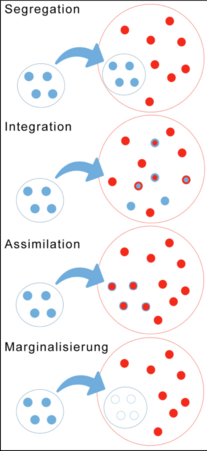Acculturation facts for kids
Acculturation is a term used to describe how an individual or a group from one culture interacts directly with an individual or group from a different culture. Sometimes, these two cultures may be similar, or they may be very different. Unlike culture shock, acculturation includes the ways both cultures influence each other. Also, culture shock is only focused on the individual or group who is entering a new culture. With acculturation, both cultures are looked at. Many things can be exchanged between the two cultures like language, ways of living, or foods. Acculturation is focused on the process of two cultures interacting over a long period of time, not once or twice. Cultural diffusion is different from acculturation because diffusion may occur once or twice, and means that there is an equal balance between the two things involved; with acculturation, this equal balance is not guaranteed.
Contents
History
The term acculturation was first used by people who study anthropology. They wanted to know more about how people from different cultures interact with each other and what happens when they interact. Psychologists have also been interested in studying acculturation but are interested in the effects of acculturation on individuals. Sociologists also study acculturation and how societies change from interacting with new cultures.
Models of acculturation
The process of acculturation can have four outcomes: assimilation, integration, separation, and marginalization. These four outcomes are shown in the picture to the right.
- Assimilation is when one culture loses its original identity and takes on the identity of the other culture (in the picture, all of the blue dots become red dots).
- Integration is when one culture still has some of its original identity while also trying to be a part of the other culture (in the picture, there are still blue dots in the larger circle, but some blue dots are trying to “act” or “look like” red dots; some red dots may try to look like blue dots too).
- Separation is when there is an interaction between the two cultures, but nothing is exchanged, the cultures do not change (in the picture, the red and blue dots are in the same circle, but none of them change color).
- Marginalization is when no interaction occurs between the two cultures and one culture loses their own culture (in the picture, the blue dots are in their own circle and are not colored in, while the red dots remain unchanged).
Use of acculturation in social science
Anthropologists, Psychologists, and Sociologists all use acculturation to help explain changes that happen when cultures interact. One way of measuring levels of acculturation is through acculturative stress. This measurement helps relate acculturation to other ideas or issues and helps researchers understand what happens to individuals and groups during acculturation. Many studies have looked at acculturative stress and health of individuals. Other acculturation research studies have focused on immigrantpopulations to the United States and other minority groups.
Images for kids
See also
 In Spanish: Aculturación para niños
In Spanish: Aculturación para niños



